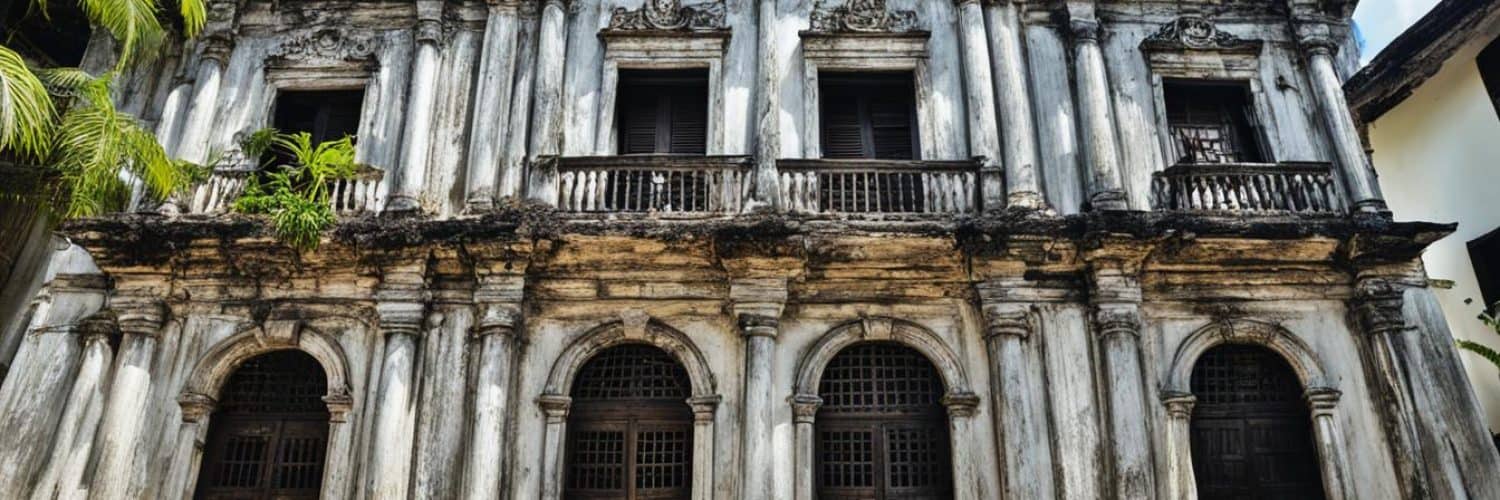Step into the fabric of Philippine history at the Jesuit House of 1730, also known as Museo de Parian, nestled in the heart of Cebu Philippines. As one of the foremost historical sites Cebu offers, this remnant of the Spanish colonial architecture captivates visitors with its storied past and lasting legacy. Whether you’re a history enthusiast or a curious traveler, this centuries-old structure, a centerpiece among cultural landmarks Cebu, provides an opportunity to absorb the rich narrative of the city’s evolution.
Jaime Sy’s serendipitous choice to preserve the building’s antiquity instead of converting it into a warehouse enriches the tapestry of tourism in Cebu, offering an authentic glimpse into the architectural and historical grandeur of the era. The remnants of the past, discovered and celebrated within these storied walls, are sure to enthral anyone stepping across the threshold.
Key Takeaways
- Discover the rich history behind the oldest dated house in the Philippines, the Jesuit House of 1730.
- Experience the essence of Spanish colonial architecture through the house’s conserved structure and design.
- Learn about the historical significance of the Parian district, once a bustling commercial center in Cebu Philippines.
- Appreciate the dedication to cultural preservation as demonstrated by the current stewards of this historical gem.
- Embrace the chance to contribute to tourism in Cebu by visiting and promoting awareness of its vital cultural landmarks.
- Glean insights from artefacts linking the site’s history to the Ming Dynasty, adding layers to the story of Cebu’s heritage.
The Historical Significance of Museo de Parian
Embedded within the bustling streets of Cebu Philippines lies a treasured emblem of the past, the Jesuit House of 1730. Today, known as Museo de Parian, it ranks among the premier historical sites of Cebu, drawing visitors eager to plunge into the depths of Jesuit heritage and Spanish colonial architecture.
Uncovering the History: The Jesuit’s Headquarters
The provenance of this cultural landmark Cebu traces back to when it served as the center of Jesuit missionary efforts in the region. Fr. William Repetti’s historical insights have lent weight to the building’s identity as the original Jesuit House of 1730, thereby anchoring it firmly into the tapestry of Philippine history.
The Earthquake-Resistant Construction: Coral Stones and Wood
Steeped in resilience, the structure’s Spanish colonial architecture, characterized by the use of thick coral stones and robust wood, illustrates a design philosophy aimed at withstanding the prevalent earthquakes in the area. This enduring nature marks the Jesuit House of 1730 not merely as a building but as a silent custodian of centuries of history.
Museo de Parian: A Time Capsule of Cebuano Heritage
Encapsulating a wealth of Cebuano heritage, the walls of Museo de Parian reverberate with stories of times long past. The site operates as a living museum, one in which every corner and corridor offers a new chapter of historical intrigue for its visitors to discover.
As the Jesuit House of 1730 continues to occupy a place of pride among the cultural landmarks Cebu, it remains a poignant journey through time for those who walk its well-trodden floorboards. Not only does it offer a glance into the past but also serves as a beacon for the preservation of Cebu’s storied heritage.
A Peek into the Past: The Diorama of 1700s Cebu
Step into the Museo de Parian and instantly transport yourself to the historical landscapes of Cebu during the Spanish colonial era. Here, a meticulously crafted diorama awaits, serving as a portal to the past. The attention to detail in the miniaturized scenery is exceptional, with every component arranged to offer an immersive glimpse into the urban fabric of 18th-century Cebu.
The diorama showcases the distinctive architectural styles prevalent during the era, from the humble native houses to the grandiose churches that once dotted the skyline. Among the standout features is the detailed representation of the Iglesia del San Juan Bautista, a structure that once held a illustrious position in Cebu’s societal and religious life but now exists only in the collective memory of the Cebuano people.
Transportation in 1700s Cebu is also depicted with precision. Horse-drawn tartanillas (carriages) are shown moving through the cobblestoned streets, indicating the mobility options of the time and bringing out the vivacity of the island’s commercial activities. These small touches breathe life into the diorama, making it not just a historical exhibit but a storybook in three dimensions.
This section of the museum doesn’t just preserve Cebuano heritage—it celebrates it. The diorama is a tribute to the legacy of Cebu, a vital historical site that intertwines the rich tapestry of Filipino history with the architectural and urban developments of the Spanish colonial era. It’s a visual narrative of how the past has shaped the identity of Cebu, rendering the Museo de Parian a landmark destination for all who wish to reconnect with the historical heart of the Philippines.
Glimpses of Filipino Ancestry: Antique Collections within Jesuit House of 1730
Step into a world where each artifact tells a story of the rich cultural heritage Cebu has to offer. The Jesuit House of 1730, a cornerstone among historical sites Cebu, showcases an array of antique collections that provide a window into the intricate tapestry of Filipino ancestry. Visitors to this must-visit museum in the Philippines are transported back in time to experience the evolution of Cebuano lifestyles, from the traditional to the transitional.
From Vintage Furniture to Old Cebuano Lifestyles
As you ascend to the second floor of Jesuit House of 1730, you’ll find a remarkable exhibition rich with nostalgia. Vintage furnishings draw visitors into the daily life of Cebuanos through the ages. The antique television sets, radios, and cameras, coupled with the resonating sounds from a jukebox, epitomize the entertainment and communication mediums of the past. Examining these memorabilia, one can’t help but ponder on the transitions of everyday life and the advancements that have led us to the present.
The “Dirty Kitchen” Exhibit: Culinary History Preserved
The Jesuit House of 1730 also features a visceral exploration into the Filipino culinary past through its “dirty kitchen” exhibit. Here, historical kitchen apparatuses, from wood stoves to clay pots, tell of a time when traditional cooking methods were a central part of Cebuano culture. This exhibit isn’t merely a display; it’s a gastronomic journey through time that affirms the house’s place among historical sites Cebu and the wider cultural landscape.
The antiquities found within these walls do more than capture moments in time; they inspire a deep appreciation for the ancestry and evolution of Cebu’s community. As you leave the confines of the Jesuit House of 1730, you take with you a richer understanding of cultural heritage Cebu, acknowledging its role as one of the premier museums that preserve not just artifacts, but the essence of Filipino history.
The Architectural Marvels of Spanish Colonial Design
Stepping onto the grounds of the Jesuit House of 1730, one is immediately transported to a time when Spanish colonial architecture was the blueprint for building in the Philippines. This unique structure in Cebu stands as a testament to the ingenuity of past eras and the enduring nature of its design. Each component of the house, from the expansive walls to the intricate roof achieves a harmonious balance between functional durability and aesthetic elegance, characteristic of the significant cultural heritage of Cebu.
Among the historical sites Cebu boasts, the Jesuit House garners particular attention for its meticulous preservation of construction methods prominent during the Spanish occupation. Visitors find themselves walking upon sturdy tugas wood floors that hold stories etched over centuries. Below an impressive terracotta-tiled roof, these floors stretch throughout rooms adorned with period-appropriate fixtures, enveloping guests in an atmosphere of historical reverence.
Below is a glance at the key architectural elements that make the Jesuit House a marvel of Spanish colonial design:
| Architectural Element | Material Used | Historical Significance |
|---|---|---|
| Exterior Walls | Cut Coral Stone | Reflecting the Spanish influence, coral stone was favored for its resilience and abundance in coastal Cebu. |
| Roofing | Clay Terracotta Tiles | The Spanish introduced these tiles which have proven to be effective for the tropical climate, remaining durable through time. |
| Flooring | Hardwood (Tugas) | The use of rich hardwood floors is indicative of the wealth and status of its original occupants. These hardwoods are celebrated for their longevity and austere beauty. |
It is not merely the materials and design that captivate, but also the conscious effort to maintain such history intact. The Jesuit House of 1730 is not just a structure; it is a bridge to a bygone era, an immersion into the Spanish-Colonial chapter of Cebu’s rich tapestry, making it an invaluable piece of the Philippine archipelago’s storied past.
Ming Dynasty Relics: Evidence of Asian Influence
Traversing the halls of the Museo de Parian in Cebu, Philippines, unfolds a narrative far beyond the local history—it harkens back to an era where the Asian influence in the Philippines was making its indelible mark. Central to this story are the Ming Dynasty relics, timeless pieces that symbolize a cultural confluence that continues to resonate in modern times. These ancient artifacts do more than just decorate the rooms; they serve as a testament to the rich Chinese heritage intertwined with Filipino culture.
The excavation and preservation of these Ming Dynasty relics shed light on a period where trade and cultural exchange flowed freely across the seas, forging connections that would shape the Philippines’ regional relationships. Among the most iconic of these relics are ceramics—dishes, pots, and vases—each meticulously crafted, telling a story of commerce, craftsmanship, and everyday life during the Ming era.
| Artifact Category | Description | Historical Significance |
|---|---|---|
| Ceramic Plates | Elegantly painted with cobalt blue patterns under a translucent glaze. | Illustrates the trade routes trade links between China and the Philippines. |
| Porcelain Vases | Tall, slender forms, with intricate scenes depicting Chinese mythology and nature. | Reflect the sophistication of Ming-era artistry and aesthetics valued by local elites. |
| Storage Jars | Large, robust containers with brown glazes, used for storing goods. | Indicative of bulk trade and the Philippines’ role as a hub for resource distribution. |
As we delve into the nuances of each relic, it becomes clear that these items are not mere remnants of the past but are living emblems of the Asian influence in the Philippines. For instance, the blue and white ceramic plates are not just visually stunning; they speak of a time when Chinese artisans were spreading their influence through trade, leaving behind legacies still palpable in today’s Filipino culture.
The Museo de Parian chronicles this rich history with dignity, engaging visitors in a dialogue with the past and inspiring a deeper understanding of the vast narrative that is the Filipino identity—an identity that, as these Ming Dynasty relics remind us, is deeply rooted in a tapestry of Asian influence.
Jesuit House of 1730 or Museo de Parian, Cebu Philippines
Step into the realm where centuries-old stories are etched into walls and the air whispers tales of the past; welcome to the Jesuit House of 1730 or the Museo de Parian in Cebu, Philippines. This revered artifact of history, shrouded in the grandeur of Spanish colonial architecture, is not just a building but a storied vessel carrying the essence of Cebu’s rich cultural heritage. Many visitors and scholars debate its claim as the oldest house in Cebu, yet what’s undeniable is its role as a testament to the artistic synthesis of Spanish influence and indigenous Filipino skill.
- Discover a physical narrative of Cebuano history within its coral stone walls and hardwood pillars.
- Appreciate the meticulous craftsmanship that has withstood natural and historic upheavals.
- Explore the interplay of cultures where East meets West under one roof.
- Enrich your knowledge of Cebu’s past through the legacy preserved in this architectural marvel.
As wanderers and connoisseurs of heritage tread its enduring floors, it’s evident that the Jesuit House of 1730 is more than a mere point on a tourist map—it is a cherished landmark that continues to unfurl the narrative of Cebu’s transformation over the centuries. To step through its doors is to traverse the silent corridors of history, where every corner and crevice has a story to tell, and time seems to unravel its tightly coiled mysteries for those eager to listen.
Religious and Cultural Significance in Cebu
Delving into the heart of Cebu’s religious and cultural saga, two emblematic landmarks stand tall as testimonies of the city’s rich past. These historical sites in Cebu not only convey the stories of their time but also secure the narrative of Filipino resilience and religious devotion, elements crucial to understanding the cultural heritage of Cebu.
The Ruins of Iglesia del San Juan Bautista
In the shuffle of everyday life, amidst the bustling streets of Cebu, lie the ruins of the Iglesia del San Juan Bautista. A once splendid fixture of Spanish ecclesiastical might, this site bears solemn witness to historical confluences—a testament to the long-standing Jesuit heritage that shaped Cebu’s religious contour. The church’s remnants, though humble, beckon historians and pilgrims alike to ponder the stories etched into its enduring stones.
The Story of the San Diego Warship and Maritime Heritage
The maritime heritage of Cebu is further anchored by the tale of the San Diego warship—a vessel that encapsulates the collaboration of Cebuano and Chinese shipwrights. Despite succumbing to the seas, the legacy of the San Diego lives on, showcasing the masterful craftsmanship and maritime ingenuity that remain cornerstones of Cebuano pride. This historical relic epitomizes the rich tapestry of cultures that have converged to forge Cebu’s storied past.
Restoration and Preservation Efforts at Jesuit House
The Jesuit House of 1730, a treasure among historical sites Cebu, is a testament to the dedicated restoration efforts that breathe new life into the centuries-old structure. The significance of the Museo de Parian as a cultural emblem is intact thanks to the comprehensive preservation tactics employed to maintain its timeless appeal and historical authenticity.
These efforts underscore the importance of cultural conservation in a rapidly modernizing world, ensuring the stories of the past continue to be told in the present. Adaptive reuse has played a critical role in this journey from a residential venue of the past to an informative museum space that now houses numerous artifacts and narratives of old Cebu.
Adaptive Reuse: From Residential to Museum Space
The ongoing transformation of Jesuit House represents a significant stride in adaptive reuse, where the historic integrity of the site is not only preserved but also given a new purpose. This reinvention enables the public to connect with the rich tapestry of Cebu’s heritage in an engaging and educational setting.
The Sy Family’s Commitment to Cultural Conservation
Behind the vigilant efforts of conservation lies the dedication of the Sy family, the stewards of the Jesuit House, who have devoted themselves to the careful and respectful restoration of this paramount piece of Cebu’s history. Their commitment extends beyond simple restoration, advocating for the preservation of such sites as a fundamental duty to cultural heritage and identity.
Visiting the Jesuit House: An Essential Tourist Guide
For history enthusiasts and travelers alike, the Jesuit House of 1730 stands out among the must-visit museums in the Philippines, offering a unique glimpse into the tourism in Cebu. This guide aims to provide prospective visitors with crucial information for planning their visit to this significant landmark.
Admission Information and Ticket Prices
The Jesuit House not only captivates with its historical charm but is also accessible to the public with an affordable admission structure. The guiding presence of a knowledgeable museum guide ensures a rich and educational experience, delving deeply into the historical significance of each artifact and narrative.
| Visitor Type | Admission Fee | Includes |
|---|---|---|
| Adults | PHP 50 | Full Access & Guided Tour |
| Students with ID | PHP 40 | Full Access & Guided Tour |
| Children (7-12 years) | PHP 20 | Full Access & Guided Tour |
| Senior Citizens & PWD | PHP 40 | Full Access & Guided Tour |
Transportation Directions and Hours of Operation
The Jesuit House of 1730 can be reached conveniently via Cebu’s iconic jeepney transportation system or other public transport means with ease. For those residing or staying nearby, a leisurely walk through the bustling streets of Cebu might also be an enriching prelude to the historical encounter that awaits.
| Details | Information |
|---|---|
| Address | Zulueta Street, Cebu City (near the Pari-an Monument) |
| Operating Hours | Daily, 8:00 AM to 5:00 PM |
| Landmark for Directions | 7-Eleven Store near Pari-an Monument |
| Transportation | Jeepney Routes: 01K, 10H, 10M |
Embarking on a journey to the Jesuit House of 1730 is not just a trip to a museum; it’s an invitation to step back in time and immerse oneself in the rich cultural tapestry of Cebu’s past. As a tourist guide to one of the must-visit museums in the Philippines, this article opens the doors to an enriching exploration that is both informative and inspiring for all who venture through its historical threshold.
The Jesuit House Museum Experience: What to Expect During the Tour
Embarking on a historical tour in Cebu at the Jesuit House museum is like stepping into a vivid tapestry of the past. Visitors will discover an intricate collage of historical depth, blended with culturally rich artifacts that reflect the multifaceted heritage of Cebu. This celebrated institution is more than a museum; it’s a threshold into the storied annals of the city’s vibrant history.
As you navigate through the corridors and chambers, each corner presents itself as a chapter in the narrative of Cebu’s colonial period. Expect to be greeted by a tableau of religious statues and historical photographs capturing the essence of Old Cebu. The Jesuit House museum experience promises to deepen one’s understanding of the layers that compose the cultural fabric of the city.
- Witness bedrooms that house precious memorabilia speaking volumes of the domestic life from yesteryears.
- Admire living areas decorated with vintage antiques, each item unraveling its unique story and place in Cebuano society.
- Explore exhibit spaces showcasing age-old religious artifacts and articles that piece together the rich tapestry of Cebu’s spiritual heritage.
For those seeking to immerse themselves in the city’s past, a tour of the Jesuit House is a key stop among the many cultural landmarks in Cebu. It’s where the past converges with the present, offering a sanctuary for heritage enthusiasts and casual tourists alike to explore, learn, and be inspired. To assure a personal and detailed exploration, the Jesuit House museum experience is thoughtfully curated to captivate visitors with historical tours that are as informative as they are enthralling.
Embark on a journey back in time, and witness the enduring legacy of a city’s culture through its most cherished remnants. Step into the Jesuit House, not just as a spectator, but as an active participant in the preservation of history.
Prepare yourself for a museum experience that goes beyond the conventional, one characterized by tales of resilience, triumph, and the enduring spirit of the city of Cebu.
Conclusion
As our journey through the Jesuit House of 1730 comes to a close, the echoes of the past linger in the hearts and minds of every visitor. This historical monument provides an illuminating snapshot into the rich tapestry of cultural heritage Cebu has to offer. A link between the bygone eras and today’s bustling city life, the museum serves as not merely a repository of relics, but rather as a living, breathing embodiment of Filipino history and cultural identity.
The significance of the Museo de Parian extends beyond its ancient walls; it stands as a touchstone for those seeking to comprehend the complex narratives that have shaped Cebu and the wider Filipino culture. Its collection, architecture, and sheer historical weight offer an unparalleled exploration into a time that firmly establishes Cebu as a cornerstone of tourism in Cebu. The indelible stories encapsulated within this abode invite a sense of awe and contemplation among those who wander its halls.
In the heart of Cebu City, the Jesuit House museum transcends its function as an attraction; it proffers a memorable history lesson, replete with insights into Spanish colonial influence, Asian trade relationships, and the Cebuano lifestyle of eras past. Such an institution not only merits a visit but also calls for engagement in its ongoing preservation. It is here, at the nexus of past and present, that we find an essential piece of the island’s enduring charm and its offer to the world – a remarkable chapter of history preserved for posterity.
FAQ
What is the Jesuit House of 1730 and where is it located?
The Jesuit House of 1730, also known as Museo de Parian, is one of the oldest historical sites in Cebu, Philippines, situated in the Parian district. It’s a preserved monument of Spanish colonial architecture and a museum that showcases Cebuano cultural heritage.
Why is the Jesuit House of 1730 significant?
This ancient house is significant as it serves as a witness to Cebu’s history, dating back to the Spanish colonial era and the time of the Jesuits in the 1700s. It represents the Spanish influence on Filipino culture and architecture, as well as the historical connections between Asia and the Philippines.
What kind of construction materials were used in the Jesuit House?
The Jesuit House was built using coral stones and wood, notably tugas hardwood for its floors, making it earthquake-resistant. These materials were chosen for their durability, a common practice during the Spanish colonial period.
Are there any exhibits or collections inside the Jesuit House museum?
Yes, the Jesuit House museum showcases a range of exhibits. This includes a diorama of 1700s Cebu, antique furniture, vintage items narrating Cebuano lifestyles, and a “dirty kitchen” exhibit displaying historical culinary equipment.
Can you tell me more about the Asian influence apparent in the Jesuit House?
The Jesuit House museum houses Ming Dynasty relics, especially ceramics, which highlight the significant Chinese heritage and the historical influence of Asia in the Philippines that dates back several centuries.
What are the museum’s operating hours, and is there an admission fee?
The Jesuit House museum operates daily from 8:00 AM to 5:00 PM. There is an affordable admission fee, which helps in the preservation and maintenance of this important cultural landmark.
How can I get to the Jesuit House of 1730?
Located along Zulueta Street near the Pari-an monument, the Jesuit House is accessible via jeepney transportation in Cebu. It is also a short walk from the prominent 7-Eleven convenience store in the area.
Is there any information on the religious significance of the Jesuit House?
Yes, the museum holds artefacts and stories related to the city’s religious history, including the remains of the Iglesia del San Juan Bautista church and maritime heritage tales such as that of the San Diego warship.
What sort of restoration has the Jesuit House undergone?
The Jesuit House has seen continuous restoration efforts to preserve its original form and function. Adaptive reuse has allowed the old residential house to be repurposed into the current museum for visitors to enjoy a piece of Cebu’s rich history.
What can visitors expect during the tour of the Jesuit House museum?
Visitors can anticipate an interactive experience with guided tours explaining the importance of each artefact and exhibit. The rooms such as bedrooms and living areas display historical memorabilia, offering guests insights into the evolution of Cebuano culture and lifestyle.











Add comment